m (→Background) Tag: Visual edit |
No edit summary Tag: Visual edit |
||
| Line 9: | Line 9: | ||
|death place = Virginia Tech, Blacksburg, Virginia, U.S. |
|death place = Virginia Tech, Blacksburg, Virginia, U.S. |
||
|job = University student |
|job = University student |
||
| − | |pathology = [[ |
+ | |pathology = [[Mass Murderer]]<br>[[School Shooter]] |
|mo = Shooting |
|mo = Shooting |
||
|victims = 32 killed<br>17 attempted |
|victims = 32 killed<br>17 attempted |
||
Revision as of 10:40, 17 September 2019
| “ | You have vandalized my heart, raped my soul, and torched my conscience. You thought it was one pathetic boy's life you were extinguishing. Thanks to you, I die like Jesus Christ, to inspire generations of the weak and defenseless people. | ” |
— Cho about his massacre
| ||
Seung-Hui Cho was a Korean mass murderer and school shooter who perpetrated the Virginia Tech shooting, which left 33 people dead (including Cho himself) and 23 wounded.
Background
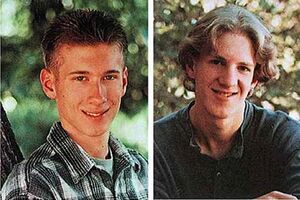
Cho was born in Asan, a city in the South Korean province of South
Chungcheong, and lived in a basement apartment with his family. His father ran his own bookstore but didn't make much money from it. In September 1992, when Cho was eight years old, the family moved to the United States, eventually settling in Centreville, Virginia, a town in Northern Virginia, which had a large Korean community. There, the family became avid Christians. A quiet boy, he never socialized much with his family, causing relatives to believe he was selectively mute or had some sort of mental illness. In high school, Cho was teased and sometimes bullied for his usually-silent nature. When he did speak, he was mocked because of it, with one student saying "Go back to China", though he was from South Korea. On April 20, 1999, while Cho was in the eighth grade, two bullied students attending Columbine High School, Eric Harris and Dylan Klebold, committed a deadly massacre at the school, killing 12 students and one teacher before committing suicide, an incident that made national news. Cho became "transfixed" by the news, and when he voiced a need to "repeat Columbine", he was immediately sent to a psychiatrist, who diagnosed him as having selective mutism.
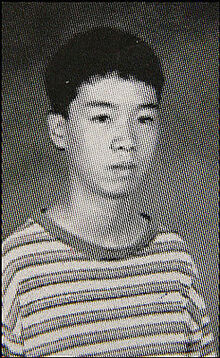
Cho yearbook photo
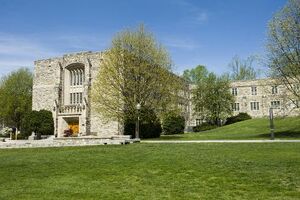
Norris Hall.
Graduating from high school in 2003, Cho was enrolled at the Virginia Polytechnic Institute and State University, a.k.a. "Virginia Tech", as an undergraduate major in business information technology, but later changed his major to English for reasons never specified. During his entire stay, Cho began referring to himself as "Question Mark" and even putting a question mark for his name on a sign-in sheet. A few weeks after the semester began, Cho's poetry professor made a request for him to be removed from her class when he began photographing female students' legs and writing violent poetry. However, the school officials turned down the request, believing these actions to not be threatening enough. Cho also began stalking two female students, to which he received verbal commands from campus police to stop. When Cho told a roommate that he "might as well kill himself", he was sent to a mental health facility. However, treatment was recommended for him as an outpatient. But because he wasn't involuntarily committed as an inpatient, it was still legal for Cho to purchase firearms. Two months prior to the shootings, Cho successfully purchased his weapons; he also took pictures, made videos, and wrote documents voicing his emotions and opinions and put them into a package.
The Massacre
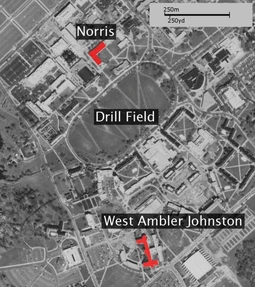
Map of Virginia Tech, with West Ambler Johnston Hall and Norris Hall (locations of the shootings) highlighted in red.
"...I didn't have to do this. I could have left. I could have fled. But no, I will no longer run. It's not for me. For my children, for my brothers and sisters that you fucked;, [sic] I did it for them... When the time came, I did it. I had to...You had a hundred billion chances and ways to have avoided today, but you decided to spill my blood. You forced me into a corner and gave me only one option. The decision was yours. Now you have blood on your hands that will never wash off."
Finally, on April 16, 2007, Cho arrived at Virginia Tech's West Ambler Johnston Hall, a co-ed residence hall, at about 6:45 a.m. Easily accessing the hall due to the fact that his student mailbox was located there, he entered room 4040, on the fourth floor. There, he shot and injured freshman Emily Hilscher, who would die from her gunshot wounds three hours later. He then killed a male resident assistant named Ryan Clark, who heard the gunshots and attempted to aid Hilscher. For reasons unknown, he concluded his shooting at the hall and left for his room. It was assumed that he specifically targeted Hilscher because she rejected romantic advances from him sometime prior, enraging him, but this was inconclusive. At about 7:30 a.m., police arrived and classified Hilscher's boyfriend, Karl Thornhill, who was an avid gun user, as a person of interest. At around 8:00 a.m., West Ambler Johnston Hall was locked down, and about 25 minutes later, Thornhill was found by police and detained for questioning; he would later be cleared of any suspicion. During the following two hours, Cho returned to his room to change his clothes, log on to his computer to delete his email, remove a hard-drive, rearm himself, and retrieve the aforementioned media package, which he mailed off to NBC News at a nearby post office at around 9:01 a.m. Wearing a bulletproof vest, Cho then walked to Norris Hall, which houses the Engineering Science and Mechanics program, at around 9:05 a.m. He used chains he brought along to lock down the hall's main three entrances to prevent initial escape.
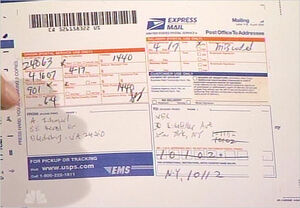
Return address for the media package sent by Cho to NBC News.
After looking into several classrooms, Cho, at about 9:40 a.m., began his shooting spree at room 206, first shooting and killing the professor, Gobichettipalayam Vasudevan "G.V." Loganathan, and then shooting eleven of the thirteen students in the room, nine of them fatally. He then went across the hall to room 207, killing the instructor, Jamie Bishop, and two students as well as injuring an additional six. At this point, several other classrooms, hearing the gunfire, began to barricade the doors. Going to room 204, whose door was barricaded, Cho was forced to shoot through the door, killing the professor, Liviu Librescu, who was an Israeli Holocaust survivor, but at that point, all but one of the students in Librescu's class were able to jump out of the windows and escape. The remaining student was also shot and killed. Cho then proceeded to room 211, whose door was also barricaded, but this time, he was able to force his way inside after killing the instructor, Jocelyne Couture-Nowak, and a student, Henry Lee, both of whom were blocking the door. He then murdered ten other students and injured an additional six. Reloading, he then revisited rooms 207 and 206, wounding two students at the former room and killing another two at the latter room. He then attempted to force his way into room 205, but the door was blocked by a large desk and Cho was unable to enter; no one in that classroom was shot. Cho then fatally shot a professor, Kevin Granata, when he ventured out of his classroom from the upper floor to investigate the gunfire. Reentering room 211, Cho then committed suicide by shooting himself in the head, ending the nine-minute-long mass shooting.
Aftermath
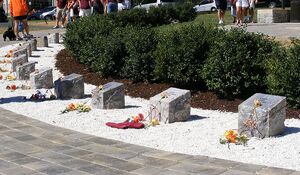
Permanent memorial of the massacre victims.
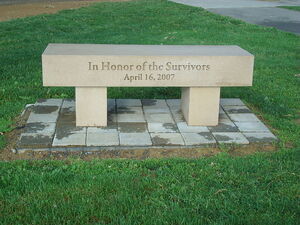
Bench dedicated to the survivors of the massacre.
In the aftermath of the massacre, Virginia Tech canceled classes for the following week in favor of an assembly and candlelight vigil, while Norris Hall was closed for the rest of the semester. There was also a response from the government, with then-President George W. Bush and his wife Laura attending the assembly and then-Virginia Governor Tim Kaine conducting a review of every aspect of the massacre. The school also came under a great deal of criticism for delaying in warning the students and professors of the danger and putting the campus under lockdown after the West Ambler Johnston Hall shootings. The gun politics debate was also put back under the spotlight under the citation of Cho being able to purchase firearms despite his mental health history. Additionally, Cho's family has also expressed shock at his actions, with Cho's older sister Sun-Kyung stating, "I don't feel that I know him."
The investigation of the massacre, which was headed by the same company that investigated the Columbine High School shootings, eventually created a final report of more than 30 pages devoted to explaining the history of Cho's mental health. In it, the Virginia Tech staff was criticized for failing to recognize the danger of Cho's behavior. A main memorial was established for the deceased victims of the massacre, and a Northern Virginia chapter named after victim Liviu Librescu, the Holocaust victim, was founded in November 2008. A more efficient alert system was also started at Virginia Tech; it has been activated three times ever since its establishment, the latest incident being when a police officer was shot and killed on December 8, 2011, with the killer, 22-year-old Ross Truett Ashley, then committing suicide, in a random act of violence.

Controversial Courier Mail cover depicting one of Cho's photos from his media package.
Many other responses stemmed from many colleges and universities worldwide as well as heads of state and international figures. Hundreds of colleges and universities sent condolences and also started their own candlelight vigils and memorial services as well as reexamining their security systems and mental health support services. Pope Benedict XVI, Queen Elizabeth II, and South Korean United Nations Secretary-General Ban Ki-moon were among those who sent condoling and sympathetic messages to Virginia Tech. Sporting teams and figures from both university and professional levels joined established fundraising efforts.
South Korea and its residents were especially affected in the aftermath. The South Korean government was forced to hold an emergency meeting to consider "possible ramifications", while another candlelight vigil was held outside the U.S. Embassy in Seoul. A 32-day fast dedicated to those killed in the massacre (one day for each victim) was called upon, but the fasting has been criticized by Korean-Americans. South Korean students attending Virginia Tech have also expressed fear that they will be subjected to racial prejudice after what Cho had done, although no incidents of such have been reported. Additionally, an announcement was made that safety measures have been established for Korean nationals in the U.S. In the wake of the gun politics debate that was sparked by the massacre, numerous foreign papers became highly critical of U.S. gun laws and gun culture.
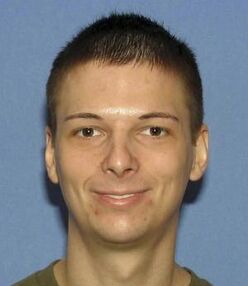
Steven Kazmierczak.
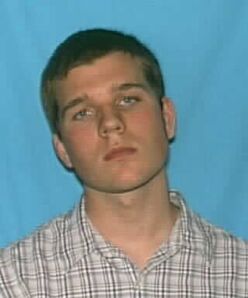
Ross Truett Ashley.
In the wake of live coverage over the massacre, not only was Cho and the event focused on, but journalistic ethics received a spotlight of criticism. During the earliest reports of the massacre, articles by Michael Sneed of the Chicago Sun-Times incorrectly identified Cho as being of Chinese descent, and his reports were cited by numerous others worldwide. Once it emerged that Cho was a South Korean national, the Chinese Foreign Ministry criticized the error. As a result of these reports, Wayne Chiang, a graduate of Virginia Tech, had been reported to be the perpetrator, even after Cho was positively identified to have committed the shooting. Additionally, the video game industry was blamed for being a contributing factor to the massacre, although Cho was never confirmed to have played violent video games. Disbarred lawyer Jack Thompson backed these claims and especially derided the tactical first-person shooter game Counter-Strike; Thompson even criticized Bill Gates, alleging that he promoted the game and demanded that Gates remove it. It should be noted that the company Valve Corporation owned and operated the game, not Gates.
However, the most controversial action the media took during coverage of the massacre was when NBC News made plans of distributing Cho's package of photos, videos, and documents to the general public. The decision came under fire of heavy criticism and controversy, with many fearing that such distribution would lead to the encouragement of copycat incidents. The head staff at NBC defended that broadcasting the material was helpful in "providing context and background on Cho's possible motivations". Finally, due to the public outcry, only a rather tiny amount of the material was distributed, although many news stations restricted the coverage; in fact, Mid-Atlantic stations even decided to stop airing it.
Like its source of inspiration, the Columbine High School massacre, the Virginia Tech massacre has motivated numerous incidents of copycat crimes, though none of them are as well-known as the attempted copycats of the Columbine High School massacre. The most notorious copycat incident appears to be the Northern Illinois University shooting, which occurred less than a year after. A 27-year-old former student named Steven Phillip Kazmierczak shot a total of 22 people, five of them fatally, with a 12-gauge Remington Sportsman 48 semiautomatic shotgun and a 9mm Glock 19 semiautomatic pistol inside a large auditorium-style lecture hall located at the university's Cole Hall before committing suicide. Also with him were two other semiautomatic pistols (a 9mm Kurz SIG Sauer P232 and a .380 ACP Hi-Point CF380), both unused. It has been stated in a report that Kazmierczak, who was diagnosed with bipolar disorder and suffering from insomnia, "studied" Cho's methods and utilized a similar M.O. Like the Virginia Tech massacre, the shooting received a large amount of reaction from the public, including the government. Also, the aforementioned murder of Deriek Wayne Crouse was associated with the massacre, with the perpetrator Ashley having actually practiced at the same shooting range as Cho.
Modus Operandi
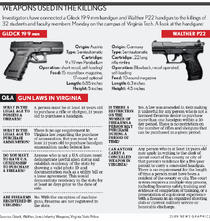
The weapons used in the massacre.
"All the [shit] you've given me, right back at you with hollow points."
Cho shot his victims with two semiautomatic pistols, one a .22-caliber Walther P22, the other a 9mm Glock 19. He used jacketed hollow-point bullets as ammunition; said bullets inflict more damage to the tissue by expanding upon entry. Cho also brought along a hammer and a knife, both of which he presumably intended to use during the massacre under the occasion that he ran out of ammunition, but the weapons were never used.
Known Victims
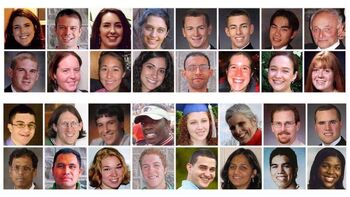
Cho's fatal victims.
Fatalities
- The West Ambler Johnston Hall shooting:
- Ryan Clark, 22
- Emily Hilscher, 19
- The Norris Hall shooting:
- Known fatalities of the two shootings in room 206:
- Gobichettipalayam Vasudevan "G.V." Loganathan, 53 (professor; killed during the first shooting)
- Waleed Shaalan, 32 (injured in the first shooting, then fatally shot in the second shooting)
- Partahi Lumbantoruan, 34 (shot repeatedly during the second shooting)
- Known fatalities of the first shooting in room 207:
- Christopher James "Jamie" Bishop, 35 (instructor)
- Maxine Turner, 22
- Known fatalities of the shooting in room 204:
- Liviu Librescu, 76 (professor; shot five times through a door, including once to the head)
- Minal Panchal, 26
- Known fatalities of the massacre in room 211:
- Jocelyne Couture-Nowak, 49 (instructor; shot through a door)
- Henry Lee, 20 (also shot through a door)
- Daniel Perez Cueva, 21
- Other fatalities in the massacre:
- Jarrett Lane, 22
- Brian Bluhm, 25
- Matthew Gwaltney, 24
- Jeremy Herbstritt, 27
- Daniel O'Neil, 22
- Juan Ortiz, 26
- Julia Pryde, 23
- Lauren McCain, 20
- Michael Pohle, Jr., 23
- Nicole White, 20
- Ross Alameddine, 20
- Austin Cloyd, 18
- Caitlin Hammaren, 19
- Rachael Hill, 18
- Matthew La Porte, 20
- Erin Peterson, 18
- Mary Karen Read, 19
- Reema Samaha, 18
- Leslie Sherman, 20
- The stairway shooting: Kevin Granata, 45 (professor; incidental)
- Known fatalities of the two shootings in room 206:
Injuries
- The Norris Hall shooting:
- Known injuries of the massacre in room 211:
- Colin Goddard (shot at least three times)
- Emily Haas (slightly wounded twice in the head by bullets)
- Known injuries of the second shooting in room 207:
- Katelyn Carney
- Derek O'Dell
- Other injuries in the massacre:
- Kevin Sterne
- Jamal Carver
- Allison Cook
- Kristina Anderson
- Erin Sheehan
- Eight other unnamed students
- Known injuries of the massacre in room 211:
- Note: There were six more reported injuries, but the victims didn't suffer any wounds inflicted by Cho; instead, they were all injured after jumping from second-story windows to escape.
Notes
- There is a man named One L. Goh (born Su Nam Ko and sometimes reported as One Goh Ko), who committed a deadly mass shooting on April 2, 2012 at the Oikos University in Oakland, California, which he formerly attended. In the incident, seven people were killed and an additional three others injured by gunshots fired from a .45-caliber handgun. He had left the university prior to the shooting (authorities initially said that he was expelled, though school officials later denied this) and also had a request for a pro-rated tuition fee reversal on his $6000 payment denied. He was suspected to have initially targeted a single female administrator, but after finding out that she wasn't present, Goh opened fire on random people instead. Goh shares several similarities to Cho: both were born in South Korea; moved to the U.S. with their families; settled in towns located in Fairfax County, Virginia; and committed massacres at the universities they attended.
On Criminal Minds
- Season Three
- "Elephant's Memory" - Cho was mentioned (though not by name) as an example of school shooters.
- Season Seven
- Novels
Sources
- Wikipedia:
- Report of the Virginia Tech Review Panel
- Hampton Roads article about several survivors of the Virginia Tech massacre
- Virginia Tech Massacre.com
- FEMA report of the Northern Illinois University shooting
- The Christian Science Monitor article about Ross Ashley
- New York Daily News article about Ross Ashley
References
- ↑ "Ismail" is misspelled, the true word being "Ishamel"
